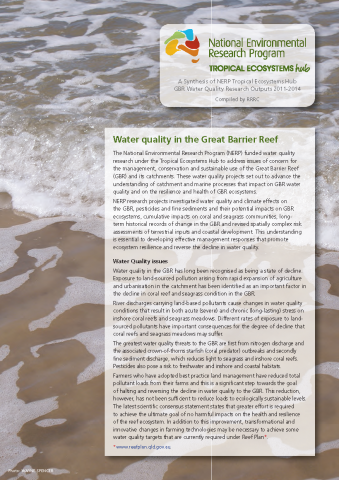Resources
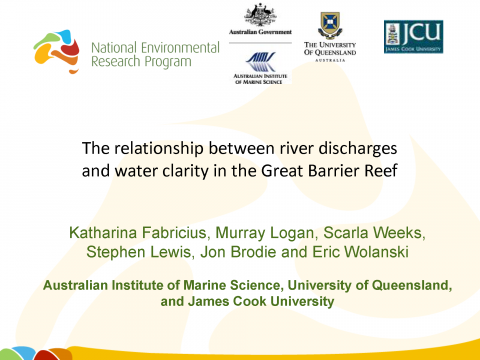 Jon Brodie (JCU); The relationship between river discharges and water clarity in the Great Barrier Reef; Thursday 6th November.
Jon Brodie (JCU); The relationship between river discharges and water clarity in the Great Barrier Reef; Thursday 6th November.
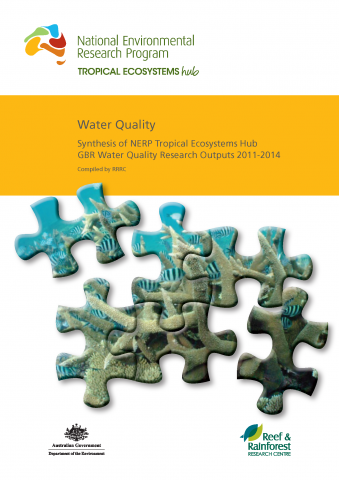 Devlin, M., Fabricius, K., Negri, A., Brodie, J., Waterhouse, J., Uthicke, S., Collier, C., Pressey, B., Augé, A., Reid, B., Woodberry, O., Zhao, J-x., Clarke, T., Pandolfi, J., Bennett, J. (2015) Water Quality - Synthesis of NERP Tropical Ecosystems Hub Water Quality Research Outputs 2011-2014.
Devlin, M., Fabricius, K., Negri, A., Brodie, J., Waterhouse, J., Uthicke, S., Collier, C., Pressey, B., Augé, A., Reid, B., Woodberry, O., Zhao, J-x., Clarke, T., Pandolfi, J., Bennett, J. (2015) Water Quality - Synthesis of NERP Tropical Ecosystems Hub Water Quality Research Outputs 2011-2014.
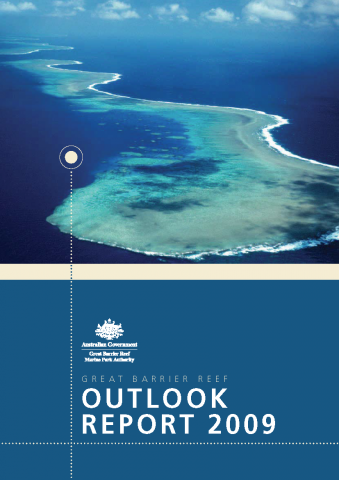 The Great Barrier Reef Outlook Report 2009 is a stock-take of the Great Barrier Reef, its management and its future.
The Great Barrier Reef Outlook Report 2009 is a stock-take of the Great Barrier Reef, its management and its future.
The aim of the Outlook Report is to provide information about:
- The condition of the ecosystem of the Great Barrier Reef Region (including the ecosystem outside the Region where it affects the Region);
• Social and economic factors influencing the Great Barrier Reef ecosystem;
• Management effectiveness of the Great Barrier Reef; and
• Risk-based assessment of the long-term outlook for the Region.
The Report underpins decision-making for the long term protection of the Great Barrier Reef. It was prepared by the GBRMPA based on the best available information and was independently peer reviewed. Many people contributed to the development of the Outlook Report including:
• Australian and Queensland Government agencies
• Leading Great Barrier Reef scientists and researchers
• Industry representatives
• Advisory committees
• Members of regional communities and the public.
The publication of an Outlook Report was a key recommendation of the review of the Great Barrier Reef Marine Park Act 1975. A report is to be prepared every five years and given to the Minister for Sustainability, Environment, Water, Population and Communities for tabling in both houses of the Australian Parliament.
The Great Barrier Reef Outlook Report 2009 is the first of these reports.
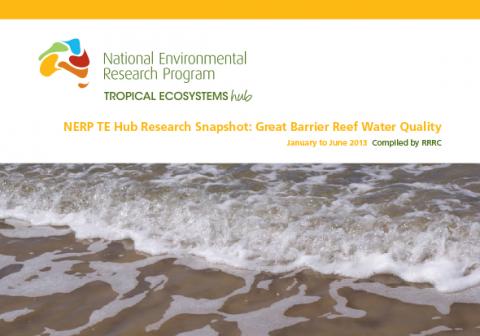 A snapshot of the research progress within the Great Barrier Reef Water Quality node for January to June 2013.
A snapshot of the research progress within the Great Barrier Reef Water Quality node for January to June 2013.
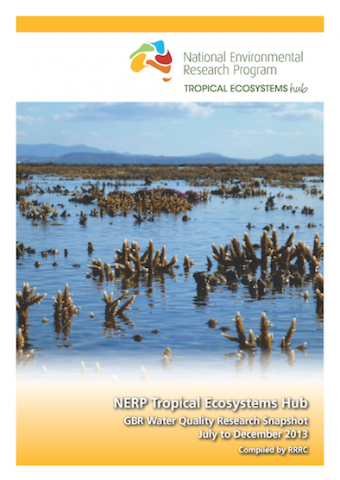 A snapshot of the research progress within the Great Barrier Reef Water Quality node for July to December 2013.
A snapshot of the research progress within the Great Barrier Reef Water Quality node for July to December 2013.
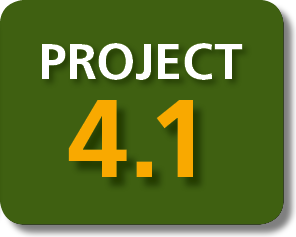
Turbidity is a measure of water clarity that quantifies the amount of small particles suspended in the water, and is a fundamental environmental parameter influencing coastal marine ecosystems. Turbidity reduces the light needed for photosynthesis by corals and seagrasses, and suspended particles also transport nutrients, pollutants and diseases. Previous research based on 3 years of turbidity data collected from 15 inshore reefs by the Reef Rescue Marine Monitoring Program has shown that it can take several months for water clarity to improve after river floods. This project will analyse a 12-year data set to demonstrate the explicit link between variations in discharge (sediments and nutrients) from the major rivers in each Natural Resource Management (NRM) region adjacent to the Great Barrier Reef (GBR) and seasonal and annual variations in water clarity in the inshore GBR.

Fabricius, K.E., Logan, M., Weeks, S., Brodie, J. (2014) The effects of river run-off on water clarity across the central Great Barrier Reef. Marine Pollution Bulletin. [doi:10.1016/j.marpolbul.2014.05.012].

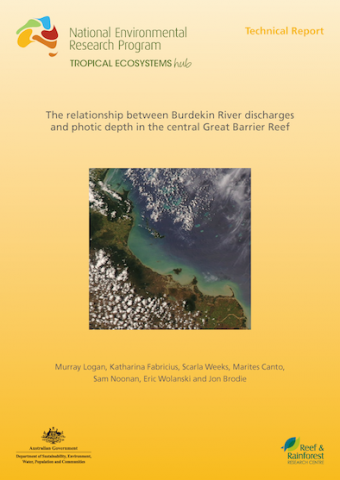 Logan, M., Fabricius, K., Weeks, S, Canto, M., Noonan, S., Wolanski, E., Brodie, J. (2013) The relationship between Burdekin River discharges and photic depth in the central Great Barrier Reef.
Logan, M., Fabricius, K., Weeks, S, Canto, M., Noonan, S., Wolanski, E., Brodie, J. (2013) The relationship between Burdekin River discharges and photic depth in the central Great Barrier Reef.
© Australian Institute of Marine Science (AIMS)
